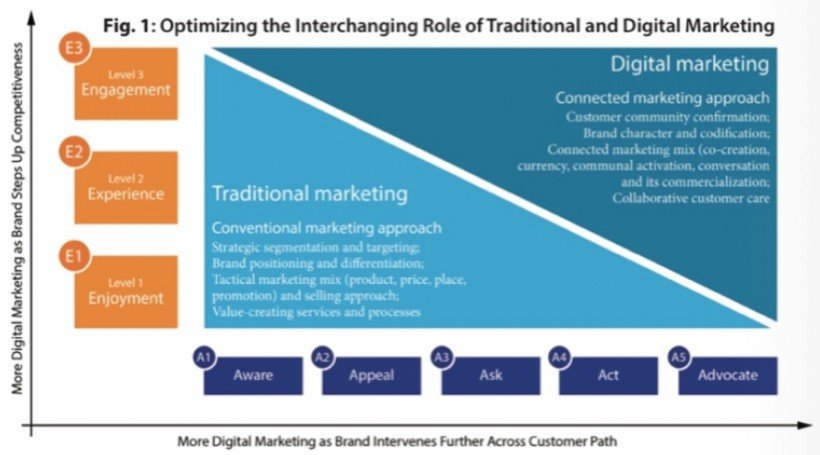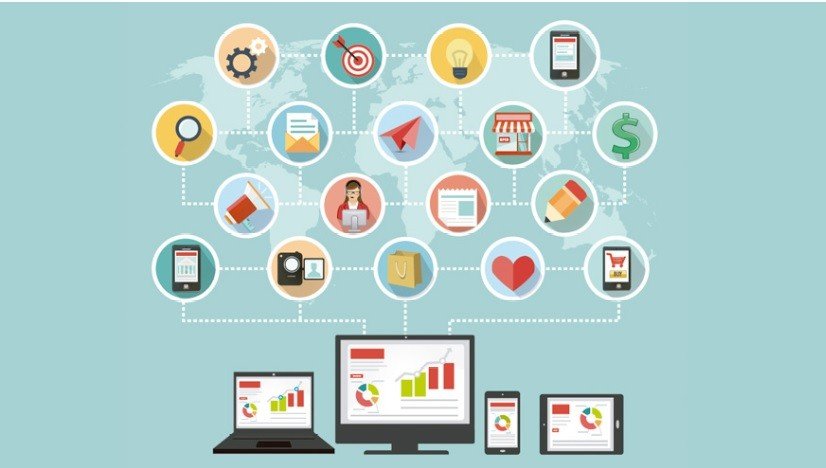La revolución del Marketing 4.0
El marketing ha sido, es y será un mundo todavía por descubrir en el que a cualquier detalle o teoría se le puede dar siempre una vuelta más para exprimir al máximo su potencial. Esta característica del marketing 4.0 nos hace cómplices, a los marketers, de un proceso de evolución y, sobre todo de revolución, cada vez más infinito e interesante.
Del Marketing tradicional al Marketing digital: 5 diferencias clave
Seguro que estamos de acuerdo en que la era digital ha conseguido abrirle las puertas al marketing tradicional, también conocido como marketing, de (casi) todos los rincones del mundo. Pero, además de la gran ventaja que presenta el alcance que ofrece el mundo digital, ¿cuáles son las diferencias más claras entre estos dos conceptos de marketing?
- El objetivo principal o targeting
El marketing tradicional se basa en vender un producto o servicio. Las características y funciones de este son el objetivo principal de los marketers. Si hablamos del marketing digital, su objetivo va mucho más allá del producto. Se basa en una necesidad real de un público o consumidor en concreto. El epicentro de todo es el consumidor, lo que le interesa y necesita, y el objetivo de los marketers es satisfacer esa necesidad.
- La segmentación
De la mano del targeting, la segmentación en el marketing offline está basada en un público generalizado, ya que el foco está en el producto y no en el comprador del producto. En las estrategias del marketing digital la segmentación es un factor de éxito, ya que las posibilidades que presentan las herramientas de hoy en día son infinitas.
- El tipo de comunicación
La comunicación en el marketing tradicional es unidireccional, nace de las empresas y llega a los consumidores con un mensaje claro y directo, pero con el marketing digital encima de la mesa vemos que la comunicación es uno de los aspectos que más ha cambiado. Totalmente bidireccional, el marketing online ha abierto el paso a una conversación entre consumidores y empresas, pudiendo no solo hablar de los productos y servicios del mercado sino también de valores, principios, problemas y soluciones más allá de lo material.
- La medición de resultados
Este factor es obvio, que es más fácil, ¿medir las impresiones que ha tenido una valla publicitaria en la M-30 o entrar en Facebook Insights y apuntar el resultado de las impresiones que ha tenido un anuncio en los últimos días? La medición de los resultados en cuanto a publicidad ha evolucionado increíblemente con el marketing digital.
- La fidelización
Junto con la comunicación, otro de los factores de éxito es la fidelización. Gracias a la buena comunicación y el foco en las necesidades del cliente, el marketing digital ofrece la posibilidad de crear y mantener un vínculo con el consumidor que aporta un beneficio para ambos. Mientras que el marketing tradicional reduce las posibilidades de fidelización debido a su foco puesto en las ventas, más que en un crear una relación a largo plazo con el consumidor.
Fuente: marketingjournal.org
La evolución del marketing tradicional hasta lo que ahora conocemos como marketing digital gracias a los avances de la tecnología ha permitido que conozcamos un sector con infinitas posibilidades de actividad y que, además, sigue en constante movimiento. Ahora que ya conoces las diferencias más importantes entre lo offline y lo online ya puedes empezar a definir una estrategia de marketing digital para tu negocio, ¿a qué esperas?
Pero como decíamos, esto no acaba aquí. Del concepto de marketing digital pasamos a lo que ahora es conocido como marketing 4.0, ¿de qué trata y qué ventajas tiene esta nueva era?
El salto al Marketing 4.0: la omnicanalidad
Como bien dice Philip Kotler, el gurú del marketing digital, “El marketing 4.0 surge cuando lo offline conoce lo online, el estilo conoce la substancia, y las máquinas conocen al humano”.
Antes hemos comentado las principales diferencias entre lo tradicional y lo digital, pero esto no significa que lo tradicional ahora esté obsoleto. Todo lo contrario. El marketing 4.0 es la combinación perfecta del mundo offline y el mundo online, y defiende que ambos coexistan y aporten lo mejor de cada uno al consumidor.
Los aspectos fundamentales que caracterizan el marketing 4.0 y que soportan esta nueva era digital son algunos de los que te menciono a continuación:
- El consumidor como centro de todo.
- Trabajar los datos como factor clave tu estrategia, “Big Data”.
- Transparencia en las estrategias ante todo.
- Accesibilidad y comunicación constante con los usuarios.
- Saber escuchar al mercado y tener una actitud proactiva.
- Mantener un compromiso social y económico.
- Ofrecer y entender la seguridad y la privacidad.
El marketing 4.0 nos ofrece una cantidad inmensa de opciones y conexiones entre usuarios, entre empresas y, para mí lo más destacable e interesante de este, conexión entre culturas. Tenemos a nuestra disposición tanta información y herramientas útiles para satisfacer necesidades, unir inquietudes y resolver problemas que debemos, como marketers, mirar por el buen uso de las mismas, exprimiendo su potencial y redescubriendo el marketing día a día.
Tendencias 2020 en Marketing Digital
Después de todo lo que hemos comentado en este post parece que el marketing digital está en su punto más alto de evolución, recogiendo lo mejor de lo tradicional y explotando lo mejor de lo digital. Pues no, y menos mal… ¡nos queda tanto por descubrir!
Para terminar te voy a dejar aquí algunas de las tendencias que podremos ver en el próximo año:
- Las búsquedas por voz: la manera de hacer búsquedas en internet está cambiando. Ya no buscamos palabras sueltas como “comer paella”, ahora decimos “Siri, busca sitios para comer paella cerca de aquí”. La mitad del potencial de este tipo de búsqueda está aún por descubrir y estoy segura de que el año que viene iremos viendo parte de ello.
- La automatización: procesos y servicios automatizados, desde emails hasta chatbots, la automatización de procesos es el futuro más cercano. Eso sí, seguiremos necesitando personas que controlen los procesos estratégicos.
- Internet como televisión: el modelo de éxito de HBO, Netflix, Amazon… poco tardarán otras productoras en aprovechar la ola de tendencia y transformar por completo el consumo de televisión.
- Influencer Marketing: la comunidad de usuarios se fía del contenido de valor, y ese contenido está cada vez más presentado por usuarios con cierta influencia en las redes sociales. No es de extrañar que este modelo de negocio evolucione y atraiga nuevas formas de publicidad en los medios sociales.
En Digital Menta somos profesionales del marketing digital y formamos un equipo actualizado con las últimas novedades y estrategias para impulsar tu negocio hacia el éxito. Si necesitas ayuda con cualquier duda sobre el mundo digital, ¡no dudes en contactarnos!





